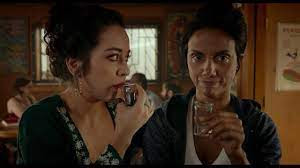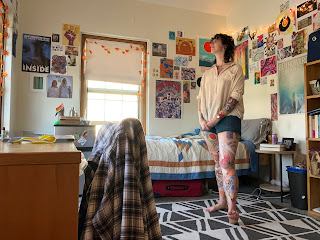Audience and Patriarchy: Signature Move (2017)
One question I was curious about from our class this week was the question of the audience that Signature Move (2017) was created for. I was thinking about how the film does not paint a perfectly Utopian romance, nor does it paint a perfectly tragic romance, like many films about queer people that make it into the mainstream do. Someone watching the film would get a weird, semi-unsatisfying view of gay love and sexuality and relationships, at least in terms of expectations set up by previous mainstream media. Someone in my group said that because of the awkward, artificial, unrealistic/uncomfortable nature of Zaynab and Alma's relationship if someone watched this to learn about gay people, they would think all gay relationships are like that and might view gay relationships in a negative light. However, I think the only people who would draw such a conclusion are straight/cis/non-queer people, or maybe even white queer people too. Non-queer straight people aren't watching Signature Move to learn about gay people. Non-queer people will watch movies more in the mainstream, which are often presented to position the audience as an outside viewer instead of a participant.
I would therefore draw the conclusion that Signature Move is not created for such a non-queer audience, and is instead directed towards queer and gay people of color who see their experiences represented and possibly humanized as sometimes funny, sometimes awkward, and weird. My strongest point of evidence for this is the scene in which Alma and Zaynab have their big semi-climactic argument. In that argument, Alma says “I don't know you well enough to be this upset. This is so lesbian. This is so lesbian. I mean seriously this is the gayest thing we could be doing right now”. I think the struggles of gay people and particularly gay people of color dealing with being othered and marginalized lead to a lot of situations like this in queer relationships. So, as a movie written by a gay woman of color about gay women of color, I think this scene and a lot of the movie might then speak louder to a more queer audience. I will say here that I have only had one "real" gay relationship myself, so I don't have a lot of experience and can't speak definitively at all about how this movie would be received by people who have been in more gay/lesbian relationships. If any of y'all disagree with me about this interpretation I would love to hear your thoughts. I could definitely be wrong and I am open to that.
I think I could talk a lot more about the possible ramifications of the film's intended versus actual audience, particularly about how the uncomfortable/artificial/unrealistic relationship might affect queer audiences, but I do want to talk a little bit about the Cherrie Moraga article.
 |
| Cherrie Moraga is second from the right, the shortest one in the picture. |
One quote I was particularly interested in was about gay men, who “Like women, they see the macho’s desire to dominate the feminine, but even more intimately because they both desire men and share manhood with their oppressor” (233). This quote sort of stems from an earlier one: “In reaction against Anglo-America’s emasculation of Chicano men, the male-dominated Chicano movement embraced the most patriarchal aspects of it’s Mexican heritage” (230). White-supremacist American patriarchal capitalist society oppresses anything that does not fit those dominant categories. By diminishing Chicano men in comparison with white men, they then become less than men entirely, and are suppressed by both white supremacy and patriarchy, and then attempt to uplift themselves under those values by oppressing Chicano women. Going back to the first quote, Moraga connects this to a particular conflict in gay men who simultaneously uphold and challenge patriarchy and white supremacy with their very existence. Moraga uses this explanation to demand that gay Chicano men make room for women (and presumably non-men in general) in the Chicano movement by giving up "their subscription to male superiority" (233). I enjoyed this article a lot, particularly Moraga's focus on intersectionality. This moment, in particular, gave a new perspective and explanation to an old problem that I now understand a lot better.
I hope y'all had a great midterm reading period!
Madeleine



Comments
Post a Comment